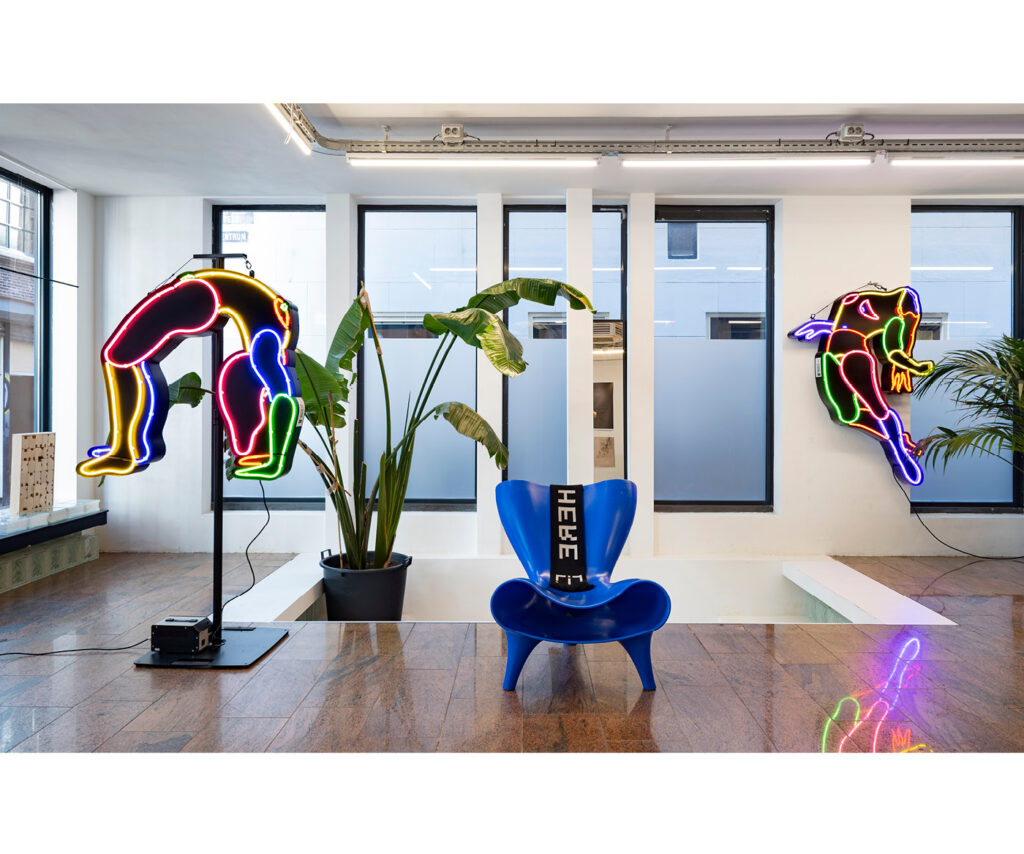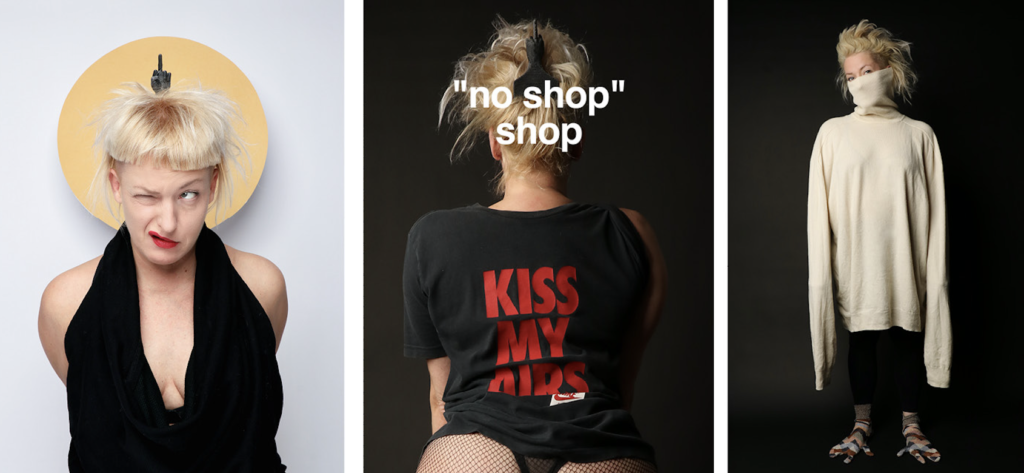Amsterdam’s infamous Red Light District is best known for vice and illicit nocturnal meetings. Yet something new and rather unusual has popped up known as the “no shop” shop. Conceived and produced by multiple identities, a design agency long based in the neighbourhood, the new highbrow-meets-lowbrow concept is intended as a conversation starter, rather than a transactional space. The project aims to offer a creative alternative to tourist retail and luridly advertised sex work.
A window display presents various items that seem on first glance to be for sale – but on closer inspection are not. And that’s the point. There are clothing and fashion accessories, ceramics, neon sculptures and something that might be conceptual art. This is definitely not your typical Red Light District store (or window). To the contrary, this is a ‘friendly offensive’ against what has become the accepted norm in this neighbourhood: fast fashion outlets and garish shops purveying tacky souvenirs and throwaway novelty merchandise. But it also sets out to challenge and reimagine what retail can – and should – be in 2024.
Shedding new light on Amsterdam’s Red Light District, the“no shop” shop invites both visiting and local audiences to discover a quality selection of work by predominantly local artists, designers, artisans, and entrepreneurs, which includes CATTL by Thecla Schaeffer; Markus Bauer’s SadSad Studio/Soyboy and Florence Weber’s Studio Encore, iconic bags by cult brand Vlieger & Vandam – and much much more – multiple identities own product included.
It’s an ongoing rotation of some of the brave and brilliant hands and minds that make contemporary Amsterdam an intensely creative city, showcased in the agency’s spacious corner studio at the centre of a neighbourhood that is ripe for cultural innovation and transformation. Because the “no shop” shop window is actually the threshold of the multiple identities studio – and a gateway into deeper engagement with local culture and craft.

Retail is dead. Long live retail.
The “no shop” shop concept is a ‘kijkshop’ (kijk means look in Dutch) by day, and a ‘peepshop’ after hours, referring to the Red Light District environment where so many visitors merely come to window shop, rather than actually providing custom to sex workers. “Kijken, kijken, niet kopen”as the common Dutch expression goes: “Look don’t touch buy”. None of the objects on display are for sale in the “shop” but rather seduce visitors into their universe of smart and critical art, design and craft. QR codes lead visitors to online and offline spaces where they can follow up on their enthusiasm for these creatives, by seeing and learning more, subscribing to updates, or – ultimately – by purchasing bespoke or custom creations, limited edition offers, made to order apparel and on-demand 3D printed objects.
If it looks like a shop…
Is it a concept store? An exhibition? A prank? Or an experiment? By day, the door is open to passersby lured in by the vibrant design objects displayed in the windows. Inside, in the multiple identities studio, they will find not only a curated selection of more products by local makers, but also a creative workspace: where the designers of the multiple identities studio craft their clients’ assignments and their own design projects. There, you might also find other creatives holding office, with friends and fellow local makers and shakers dropping by routinely. In other words, this is neither a gallery nor a shop, but rather a welcoming playground for cultural exchange, brave innovation and community engagement. By highlighting the diversity and resilience of the local creative community, the “no shop” shop aims to contribute to a more nuanced, respectful and positive understanding of this complex downtown area of Amsterdam. How’s that for a souvenir?

multiple identities founder Jacqueline Haeberle explains: “I created the ‘no shop’ shop as a reaction to the fact that stores are – completely inadvertently – becoming showrooms: these days customers come and look, then go home and then find the cheapest version online somewhere else. And then: order three sizes, and then send at least two of them back. This is of course unsustainable on every level. For retail as a concept, but also in terms of resources. So my idea was to actually claim that space. Make a shop that’s specifically and intentionally a showroom. Where the whole point is that you look, consider – and then order online. But the difference here is that most of the products displayed get produced to order, and then sold – rather than over-produced and under-sold. One of retail’s dirty secrets is that brands produce based on overly optimistic forecasts – which pleases shareholders and creates fake inflated value. This translates into defects, unwanted produce and landfills. Our remedy is simple; small production runs, on-demand 3D objects and custom apparel made close to where it needs to be shipped. No returns possible, and a bit of education and a reality check on the side.”

The ‘multiple identities’ creatives on display at the “no shop” shop
Delta/APT _ Boris Tellegen
PackBags _ Alei Verspoor
CATTL _Thecla Schaeffer
PBG / Plant Based Gallery _ Doron Beuns & Etienne Cootjans Studio Wesseling _ Floor Wesseling
SadSad Studio/Soyboy _ Markus Bauer
Vlieger & Vandam _ Carolien Vlieger & Hein van Dam Christina Diebel _photography
Permanent _ Iris van Melsen & Ben van Brummelen Mukakasa _ Christine Mukakasa
Maison Indigo _ Myriam Mense
DraadPraat _ Sara de Lange
Studio Encore_ Florence Weber
multiple identities – mi
Jacqueline Haeberle & multiple identities
South German-born designer Jacqueline Haeberle [Ulm, 1973] was raised in the ‘80’s, nurtured in the ‘90’s, and founded multiple identities in London in 1999 after her studies. In 2002 a move to Herzogenaurach marked her step into corporations, starting with Puma’s intention to set itself up as a lifestyle brand, as well as working with E.Hugh on the side [Royal Elastics, Burton]. In 2004 she became part of Nike and its innovation kitchen Europe team: the force behind White Label and Nike considered apparel –- leaving the swoosh with the famous kiss my airs [goodbye] slogan. In 2007 she embarked as creative director at what was then a start- up: K-Swiss Apparel. Ever since 2009, she has operated independently as a mother, leader, designer and creative conceptual strategist at multiple identities and in the fast evolving intersection of fashion, design, art, culture and technology – critically curating the “less- but- better” approach on an international scale and in favour of a sustainable future.



